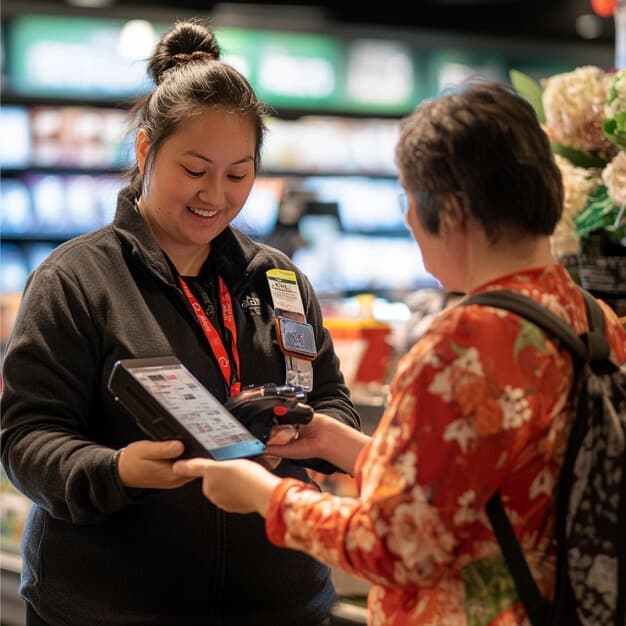The US Shopper’s Guide to Japanese Store Loyalty Programs: Maximize Savings

The US Shopper’s Guide to Japanese Store Loyalty Programs: Earn Points and Save Up to 25% explores how US shoppers can leverage Japanese store loyalty programs to maximize savings, offering insights into point systems, exclusive deals, and strategic shopping tips for a rewarding and cost-effective experience.
Navigating the world of shopping in Japan can be an exciting experience, but it’s even better when you can save money while doing it! The US Shopper’s Guide to Japanese Store Loyalty Programs: Earn Points and Save Up to 25% helps you unlock significant savings by understanding and utilizing the various loyalty programs available.
Understanding Japanese Store Loyalty Programs
Japanese stores are renowned for their customer service and attention to detail. One aspect of this is their extensive use of loyalty programs, designed to reward repeat customers and encourage brand loyalty. For US shoppers, understanding these programs can lead to significant savings and a more enjoyable shopping experience.
These programs often differ from those in the US, with unique structures and benefits that can be quite rewarding once understood. They are designed not just to offer discounts, but also to foster a long-term relationship between the customer and the store.
The Basics of Point Systems
Most Japanese store loyalty programs revolve around a point system. For every purchase you make, you earn a certain number of points, typically based on the amount you spend. These points can then be redeemed for discounts on future purchases or other exclusive benefits.
The earning rate can vary from store to store, but a common rate is 1% of the purchase amount. This means that for every 1000 yen you spend, you earn 10 points, which can then be used to offset future purchases. Some stores also offer bonus points during special promotions or events.

Types of Loyalty Cards Available
There are primarily two types of loyalty cards: physical cards and digital cards. Physical cards are traditional plastic cards that you can carry in your wallet, while digital cards are accessed through a store’s mobile app.
Many stores are now shifting towards digital cards for convenience and environmental reasons. With a digital card, you can easily track your points balance, receive personalized offers, and make payments all in one place. Plus, you don’t have to worry about losing your physical card.
- Physical Loyalty Cards: Traditional, easy to use but can be easily lost.
- Digital Loyalty Cards: Conveniently stored on your smartphone, eco-friendly and offers additional features.
- Credit Card Linked Programs: Combine shopping points with credit card rewards for maximum benefits.
By grasping these fundamental aspects, US shoppers can fully leverage Japanese store loyalty programs, leading to substantial savings and a richer shopping experience.
Maximizing Your Savings with Loyalty Programs
Once you understand the basics, the next step is to maximize your savings. This involves strategically planning your shopping trips, taking advantage of special promotions, and understanding the nuances of each program.
Effective utilization of these programs can lead to discounts ranging from 5% to 25% or even more, depending on the specific store and your shopping habits. The key is to stay informed and be proactive in accumulating and redeeming points.
Strategic Shopping Tips
One of the best ways to maximize your savings is to consolidate your purchases at stores where you have a loyalty card. Instead of shopping at multiple stores, try to buy as much as possible from a single store to accumulate points faster.
Another tip is to pay attention to special promotions and events. Many stores offer bonus points during certain times of the year, such as holidays or anniversaries. By timing your purchases to coincide with these promotions, you can significantly boost your points balance.
Understanding Point Expiration
It’s crucial to note that points often have an expiration date. Make sure to check the terms and conditions of each program to understand when your points will expire and plan your redemptions accordingly.
Some programs may have a short expiration period, such as six months, while others may allow you to accumulate points for a year or more. Keeping track of these dates will prevent you from losing valuable points.

Combining Points with Other Discounts
Many stores allow you to combine your loyalty points with other discounts, such as coupons or sale prices. This can lead to even greater savings, especially during clearance events.
Always ask customer service if you can combine your points with other offers before making a purchase. Some stores may have restrictions, but it’s always worth checking to see if you can maximize your discount.
- Consolidate Purchases: Focus your shopping at stores where you have a loyalty card.
- Monitor Promotions: Keep an eye out for bonus point events and special offers.
- Track Expiration Dates: Be aware of when your points expire and plan redemptions accordingly.
By employing these strategies, US shoppers can transform their shopping experience in Japan and unlock considerable savings through loyalty programs.
Popular Japanese Stores with Loyalty Programs
Several major Japanese retailers offer attractive loyalty programs that US shoppers can take advantage of. These programs provide diverse benefits, from points accumulation to exclusive member discounts.
These programs are not only beneficial for regular shoppers but also enhance the overall shopping experience by providing personalized offers and rewards tailored to your preferences.
Convenience Stores (Konbini)
Convenience stores, or “konbini” as they are known in Japan, are ubiquitous and offer loyalty programs that are easy to join and use. Stores like 7-Eleven, Lawson, and FamilyMart are popular choices.
These programs often offer points for every purchase, which can be redeemed for discounts on future purchases, as well as exclusive deals on selected products. They also frequently partner with other companies to provide additional benefits.
Electronics Retailers
Electronics retailers like Yodobashi Camera and Bic Camera are known for their generous loyalty programs. These programs typically offer a higher percentage of points for electronics purchases, making them a great option for those buying gadgets and appliances.
In addition to earning points, members often receive exclusive discounts on repairs and extended warranties. This can be especially valuable for expensive electronics purchases.
Department Stores
Major department stores like Mitsukoshi and Isetan also offer loyalty programs, which provide points for every purchase, as well as access to exclusive events and promotions.
These programs often cater to a more upscale clientele, with rewards such as personal shopping services, early access to sales, and invitations to fashion shows and other exclusive events.
- 7-Eleven, Lawson, FamilyMart: Easy-to-use programs with discounts and exclusive deals.
- Yodobashi Camera, Bic Camera: High percentage of points for electronics purchases.
- Mitsukoshi, Isetan: Exclusive events and promotions for a more upscale clientele.
Knowing which stores offer the best loyalty programs can guide US shoppers to maximize their savings and enjoy premium shopping experiences in Japan.
Navigating Language Barriers and Registration
One of the challenges US shoppers may face when joining Japanese store loyalty programs is the language barrier. However, many stores offer assistance in English, and there are also tools and resources available to help you navigate the registration process.
Overcoming these barriers is crucial to accessing the full benefits of the loyalty programs, ensuring you can sign up easily and understand the terms and conditions.
Tips for Overcoming Language Barriers
If you don’t speak Japanese, don’t worry. Many stores have staff who can assist you in English, especially in tourist-heavy areas. You can also use translation apps on your smartphone to help you understand the registration forms and program details.
Another helpful tip is to bring a Japanese-speaking friend or colleague with you when you sign up. They can help you navigate the registration process and explain any complex terms or conditions.
How to Register for Loyalty Programs
The registration process for loyalty programs typically involves filling out an application form and providing some personal information, such as your name, address, and phone number. You may also need to provide a Japanese address and phone number.
If you don’t have a Japanese address or phone number, you can use the address of your hotel or a friend who lives in Japan. Some stores may also allow you to use a temporary address, such as the address of a post office.
Understanding Terms and Conditions
Before signing up for a loyalty program, it’s essential to carefully read the terms and conditions. This will help you understand the rules of the program, including how to earn and redeem points, as well as any restrictions or limitations.
If you’re unsure about any of the terms and conditions, don’t hesitate to ask for clarification from a store employee or consult a Japanese-speaking friend.
- Seek Assistance: Look for English-speaking staff or use translation apps.
- Provide Necessary Information: Be prepared to provide a Japanese address and phone number.
- Read Terms: Understand the program rules to maximize benefits.
By proactively addressing language barriers and understanding the registration process, US shoppers can confidently enroll in Japanese store loyalty programs and start saving money.
Alternatives to Traditional Loyalty Programs
While traditional loyalty programs are popular, there are also alternative ways to save money while shopping in Japan. These include using discount coupons, taking advantage of tax-free shopping, and utilizing tourist-specific campaigns.
Exploring these alternatives can provide additional avenues for savings, allowing you to maximize your budget and enjoy an even more rewarding shopping experience.
Discount Coupons and Apps
Many stores and online platforms offer discount coupons that can be used to save money on purchases. These coupons may be available through the store’s website, mobile app, or in printed form.
In addition to store-specific coupons, there are also coupon apps that aggregate discounts from various retailers. These apps can be a great resource for finding deals and saving money on a wide range of products.
Tax-Free Shopping for Tourists
Japan offers tax-free shopping for tourists, allowing you to save on the consumption tax (currently 10%) on eligible purchases. To qualify for tax-free shopping, you must be a non-resident visitor and spend a minimum amount at a participating store.
When making a purchase, you’ll need to present your passport to the store employee, who will then process the tax refund. The tax refund is typically issued at the point of sale, either as a discount on your purchase or as a cash refund.
Tourist-Specific Campaigns
Many local governments and tourist organizations run campaigns to attract visitors, offering discounts and other benefits at participating stores and attractions. These campaigns are often promoted through tourist information centers, websites, and social media.
Keep an eye out for these campaigns when planning your trip to Japan, as they can provide significant savings on shopping, dining, and entertainment.
- Discount Coupons: Use store websites and coupon apps for savings.
- Tax-Free Shopping: Present your passport for tax refunds on eligible purchases.
- Tourist Campaigns: Watch for discounts at participating stores and attractions.
By exploring these alternatives, US shoppers can supplement their savings from loyalty programs and enhance their overall shopping experience in Japan.
Common Pitfalls to Avoid
While Japanese store loyalty programs offer many benefits, there are also some common pitfalls that US shoppers should be aware of. These include overlooking expiration dates, misinterpreting program rules, and failing to take advantage of special promotions.
Avoiding these pitfalls can help you maximize your savings and ensure a smooth and rewarding experience with loyalty programs in Japan.
Overlooking Expiration Dates
One of the most common mistakes is overlooking the expiration dates of your points. Points often have a limited lifespan, ranging from a few months to a year, and if you don’t use them before they expire, you’ll lose them.
To avoid this, make a habit of checking your points balance regularly and planning your redemptions accordingly. Set reminders in your calendar to alert you when your points are about to expire.
Misinterpreting Program Rules
Another pitfall is misinterpreting the rules of the loyalty program. Each program has its own set of terms and conditions, including how to earn and redeem points, as well as any restrictions or limitations.
Carefully read the program rules before signing up, and don’t hesitate to ask for clarification if you’re unsure about anything. Also, be aware that program rules can change over time, so it’s a good idea to periodically review them.
Failing to Utilize Special Promotions
Many stores offer special promotions that can significantly boost your points balance, such as bonus point events or double-point days. Failing to take advantage of these promotions is a missed opportunity to save money.
Stay informed about upcoming promotions by subscribing to the store’s email newsletter, following them on social media, or checking their website regularly. Plan your purchases to coincide with these promotions to maximize your points earnings.
- Track Expiration: Regularly check points balances and set reminders.
- Understand Rules: Read program terms carefully and ask for clarification.
- Utilize Promotions: Stay informed about bonus point events.
By avoiding these common mistakes, US shoppers can fully leverage Japanese store loyalty programs and enjoy the full range of benefits they offer.
| Benefit | Description |
|---|---|
| 🎉 Savings | Earn points for discounts on future purchases. |
| 🎁 Exclusive Offers | Get special member-only deals. |
| ✨ Bonus Points | Earn extra points during promotions. |
| 🇯🇵 Cultural Experience | Immerse in local shopping habits for an enriched trip. |
[Frequently Asked Questions]
▼
It’s a rewards system used by Japanese stores to incentivize repeat customers. Points are earned with purchases and can be redeemed for discounts or special offers.
▼
You can join by filling out an application form at the store or downloading the store’s mobile app and registering online. Some programs may require a Japanese address or phone number.
▼
Generally, yes. Most loyalty cards can be used at any branch of the store nationwide, but check the program’s terms and conditions for specific details to be sure.
▼
Yes, most loyalty points have an expiration date. The expiration period varies by store, so it’s important to check the program rules to avoid losing your accumulated points.
▼
No, they are different. Tax-free shopping is a government incentive for tourists, while loyalty programs are store-specific rewards for repeat customers. You can often use both for additional savings.
Conclusion
By understanding and utilizing Japanese store loyalty programs, US shoppers can unlock significant savings and enhance their overall shopping experience. From accumulating points to taking advantage of special promotions, these programs offer a rewarding way to make the most of your shopping trips in Japan.





